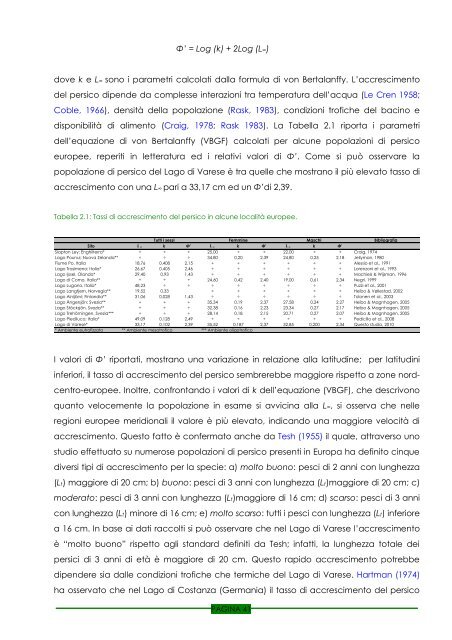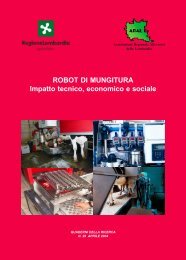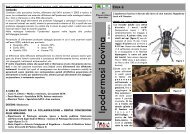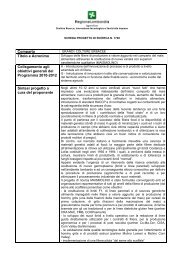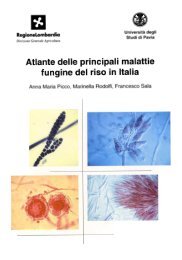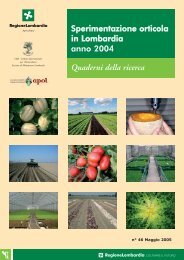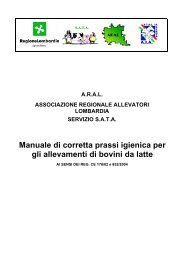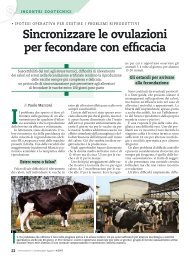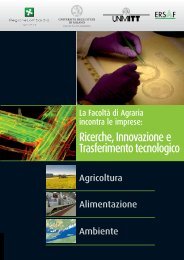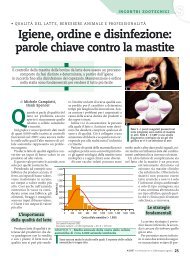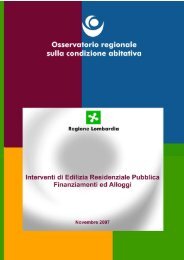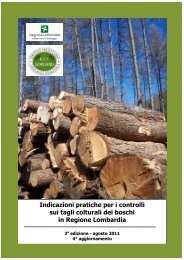(Perca fluviatilis) nel Lago di Varese - Dote Regione Lombardia
(Perca fluviatilis) nel Lago di Varese - Dote Regione Lombardia
(Perca fluviatilis) nel Lago di Varese - Dote Regione Lombardia
Create successful ePaper yourself
Turn your PDF publications into a flip-book with our unique Google optimized e-Paper software.
Φ’ = Log (k) + 2Log (L∞)<br />
dove k e L∞ sono i parametri calcolati dalla formula <strong>di</strong> von Bertalanffy. L‘accrescimento<br />
del persico <strong>di</strong>pende da complesse interazioni tra temperatura dell‘acqua (Le Cren 1958;<br />
Coble, 1966), densità della popolazione (Rask, 1983), con<strong>di</strong>zioni trofiche del bacino e<br />
<strong>di</strong>sponibilità <strong>di</strong> alimento (Craig, 1978; Rask 1983). La Tabella 2.1 riporta i parametri<br />
dell‘equazione <strong>di</strong> von Bertalanffy (VBGF) calcolati per alcune popolazioni <strong>di</strong> persico<br />
europee, reperiti in letteratura ed i relativi valori <strong>di</strong> Φ’. Come si può osservare la<br />
popolazione <strong>di</strong> persico del <strong>Lago</strong> <strong>di</strong> <strong>Varese</strong> è tra quelle che mostrano il più elevato tasso <strong>di</strong><br />
accrescimento con una L∞ pari a 33,17 cm ed un Φ’<strong>di</strong> 2,39.<br />
Tabella 2.1: Tassi <strong>di</strong> accrescimento del persico in alcune località europee.<br />
Tutti i sessi Femmine Maschi<br />
Bibliografia<br />
Sito L ∞ k Φ' L ∞ k Φ' L ∞ k Φ'<br />
Slapton Ley; Enghilterra* ÷ ÷ ÷ 25,00 ÷ ÷ 22,00 ÷ ÷ Craig, 1974<br />
<strong>Lago</strong> Pounui; Nuova Zelanda** ÷ ÷ ÷ 34,80 0,20 2,39 24,80 0,25 2,18 Jellyman, 1980<br />
Fiume Po, Italia 18,76 0,408 2,15 ÷ ÷ ÷ ÷ ÷ ÷ Alessio et al., 1991<br />
<strong>Lago</strong> Trasimeno; Italia* 26,67 0,405 2,46 ÷ ÷ ÷ ÷ ÷ ÷ Lorenzoni et al., 1993<br />
<strong>Lago</strong> Ijssel, Olanda* 29,40 0,93 1,43 ÷ ÷ ÷ ÷ ÷ ÷ Machiels & Wijsman, 1996<br />
<strong>Lago</strong> <strong>di</strong> Como, Italia** ÷ ÷ ÷ 24,60 0,42 2,40 19,00 0,61 2,34 Negri, 1999<br />
<strong>Lago</strong> Lugano, Italia* 48,23 ÷ ÷ ÷ ÷ ÷ ÷ ÷ ÷ Puzzi et al., 2001<br />
<strong>Lago</strong> Langtjern, Norvegia** 19,52 0,33 ÷ ÷ ÷ ÷ ÷ ÷ Heibo & Vøllestad, 2002<br />
<strong>Lago</strong> Ainijärvi; Finlan<strong>di</strong>a** 31,06 0,028 1,43 ÷ ÷ ÷ ÷ ÷ ÷ Tolonen et al., 2003<br />
<strong>Lago</strong> Ängersjön; Svezia** ÷ ÷ ÷ 35,34 0,19 2,37 27,58 0,24 2,27 Heibo & Magnhagen, 2005<br />
<strong>Lago</strong> Stöcksjön, Svezia** ÷ ÷ ÷ 32,38 0,16 2,23 23,34 0,27 2,17 Heibo & Magnhagen, 2005<br />
<strong>Lago</strong> Trehörningen, Svezia*** ÷ ÷ ÷ 28,14 0,18 2,15 20,71 0,27 2,07 Heibo & Magnhagen, 2005<br />
<strong>Lago</strong> Pie<strong>di</strong>luco; Italia* 49,09 0,128 2,49 ÷ ÷ ÷ ÷ ÷ ÷ Pe<strong>di</strong>cillo et al., 2008<br />
<strong>Lago</strong> <strong>di</strong> <strong>Varese</strong>* 33,17 0,102 2,39 35,52 0,187 2,37 32,85 0,200 2,34 Questo stu<strong>di</strong>o, 2010<br />
* Ambiente eutrofizzato ** Ambiente mesotrofico *** Ambiente oligotrofico<br />
I valori <strong>di</strong> Φ’ riportati, mostrano una variazione in relazione alla latitu<strong>di</strong>ne; per latitu<strong>di</strong>ni<br />
inferiori, il tasso <strong>di</strong> accrescimento del persico sembrerebbe maggiore rispetto a zone nord-<br />
centro-europee. Inoltre, confrontando i valori <strong>di</strong> k dell‘equazione (VBGF), che descrivono<br />
quanto velocemente la popolazione in esame si avvicina alla L∞, si osserva che <strong>nel</strong>le<br />
regioni europee meri<strong>di</strong>onali il valore è più elevato, in<strong>di</strong>cando una maggiore velocità <strong>di</strong><br />
accrescimento. Questo fatto è confermato anche da Tesh (1955) il quale, attraverso uno<br />
stu<strong>di</strong>o effettuato su numerose popolazioni <strong>di</strong> persico presenti in Europa ha definito cinque<br />
<strong>di</strong>versi tipi <strong>di</strong> accrescimento per la specie: a) molto buono: pesci <strong>di</strong> 2 anni con lunghezza<br />
(Lt) maggiore <strong>di</strong> 20 cm; b) buono: pesci <strong>di</strong> 3 anni con lunghezza (Lt)maggiore <strong>di</strong> 20 cm; c)<br />
moderato: pesci <strong>di</strong> 3 anni con lunghezza (Lt)maggiore <strong>di</strong> 16 cm; d) scarso: pesci <strong>di</strong> 3 anni<br />
con lunghezza (Lt) minore <strong>di</strong> 16 cm; e) molto scarso: tutti i pesci con lunghezza (Lt) inferiore<br />
a 16 cm. In base ai dati raccolti si può osservare che <strong>nel</strong> <strong>Lago</strong> <strong>di</strong> <strong>Varese</strong> l‘accrescimento<br />
è ―molto buono‖ rispetto agli standard definiti da Tesh; infatti, la lunghezza totale dei<br />
persici <strong>di</strong> 3 anni <strong>di</strong> età è maggiore <strong>di</strong> 20 cm. Questo rapido accrescimento potrebbe<br />
<strong>di</strong>pendere sia dalle con<strong>di</strong>zioni trofiche che termiche del <strong>Lago</strong> <strong>di</strong> <strong>Varese</strong>. Hartman (1974)<br />
ha osservato che <strong>nel</strong> <strong>Lago</strong> <strong>di</strong> Costanza (Germania) il tasso <strong>di</strong> accrescimento del persico<br />
PAGINA 41


